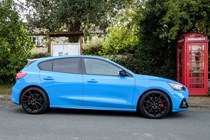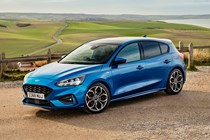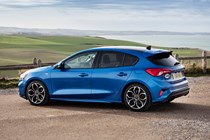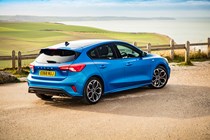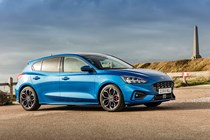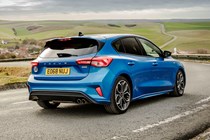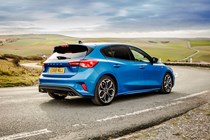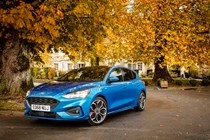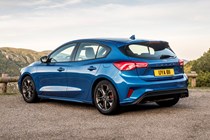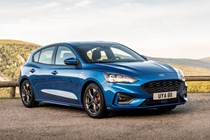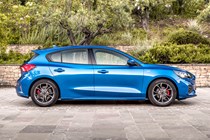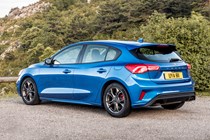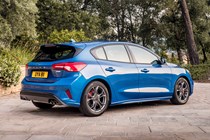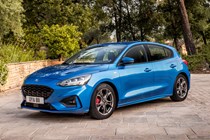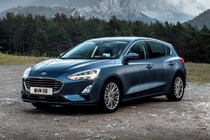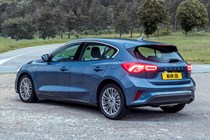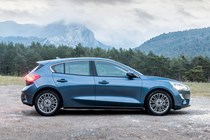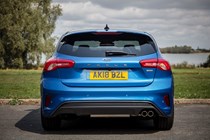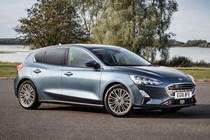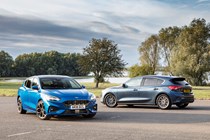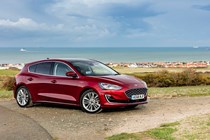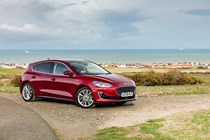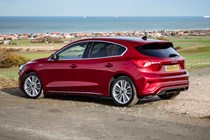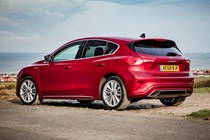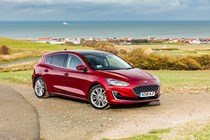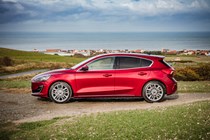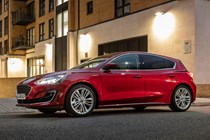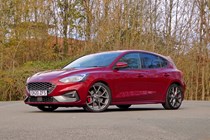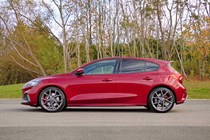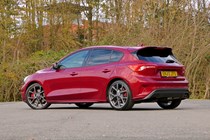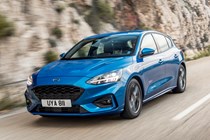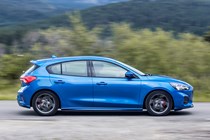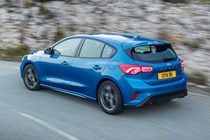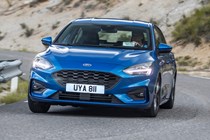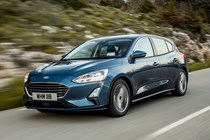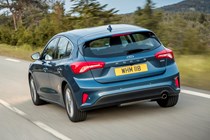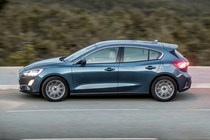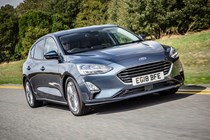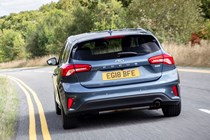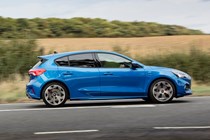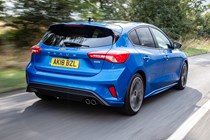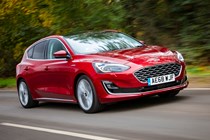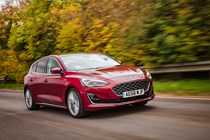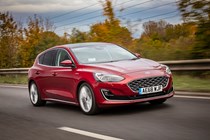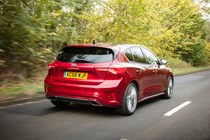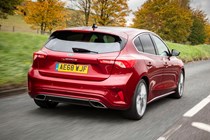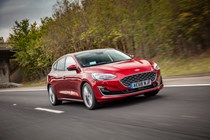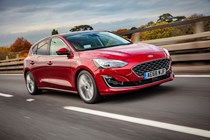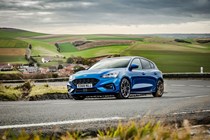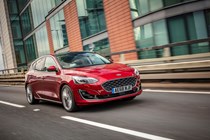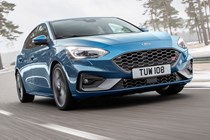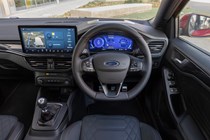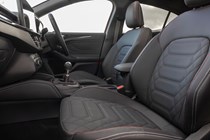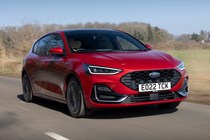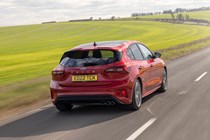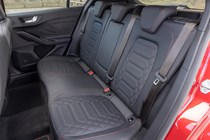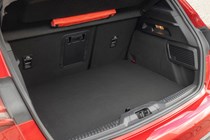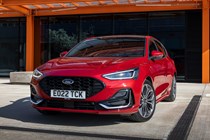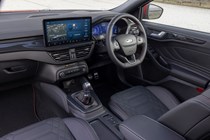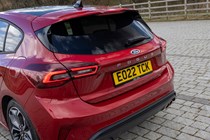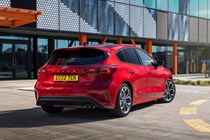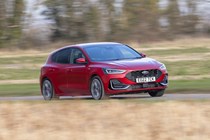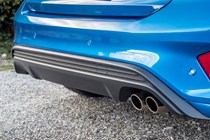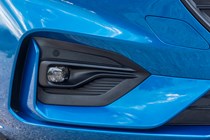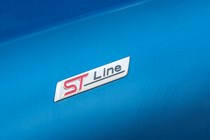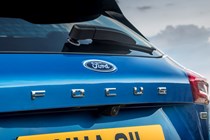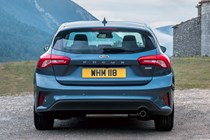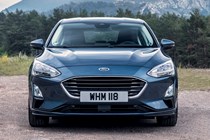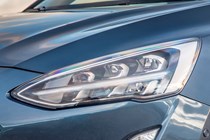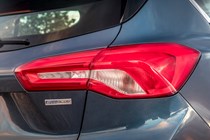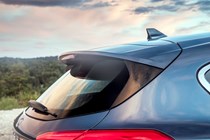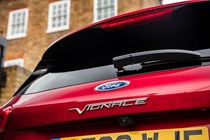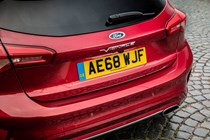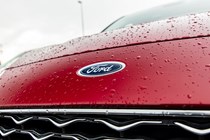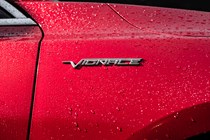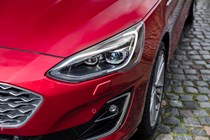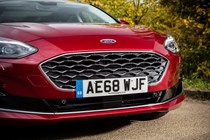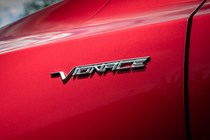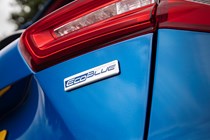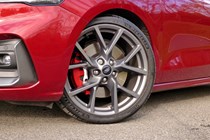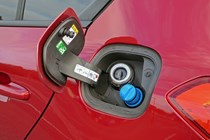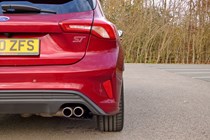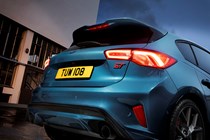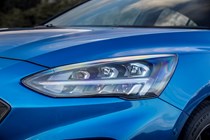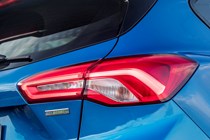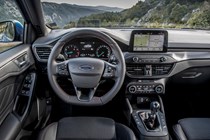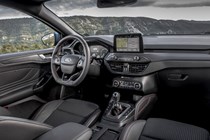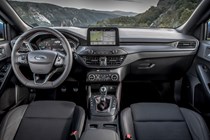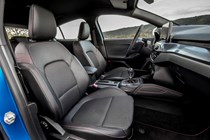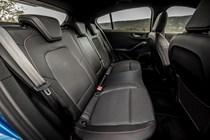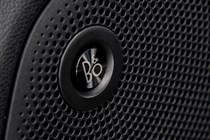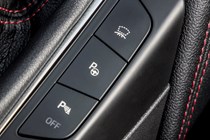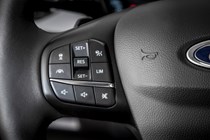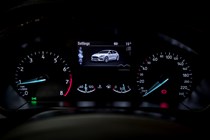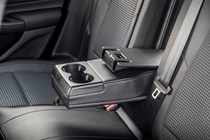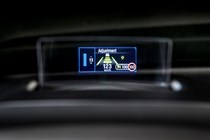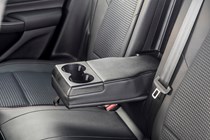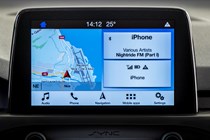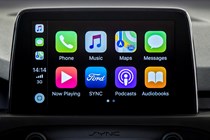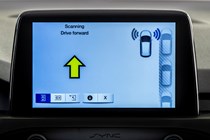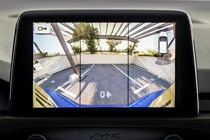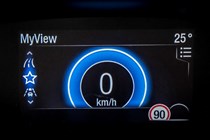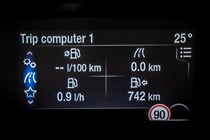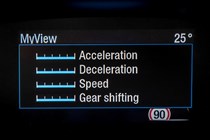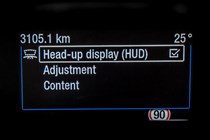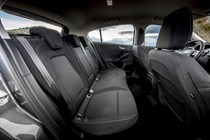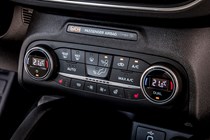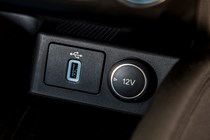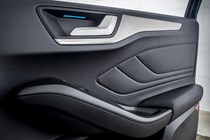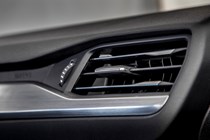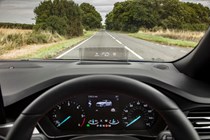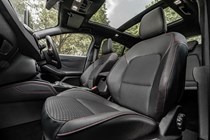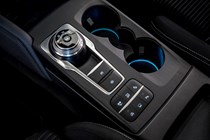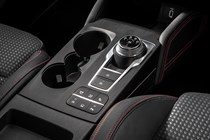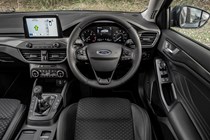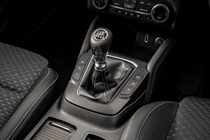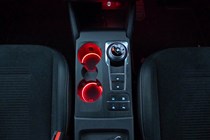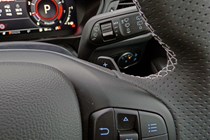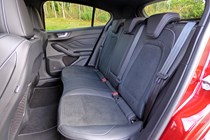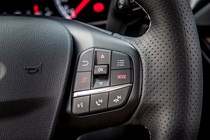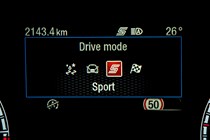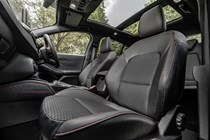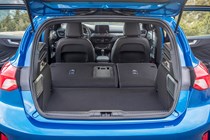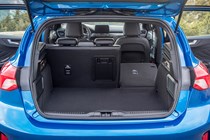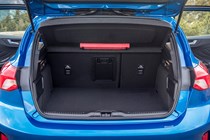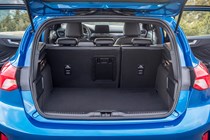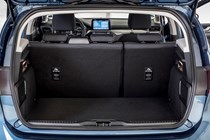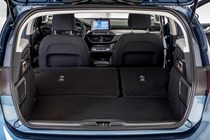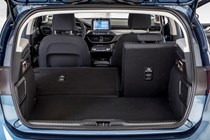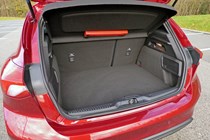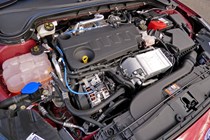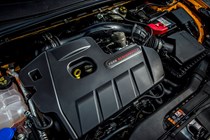Ford Focus long-term test
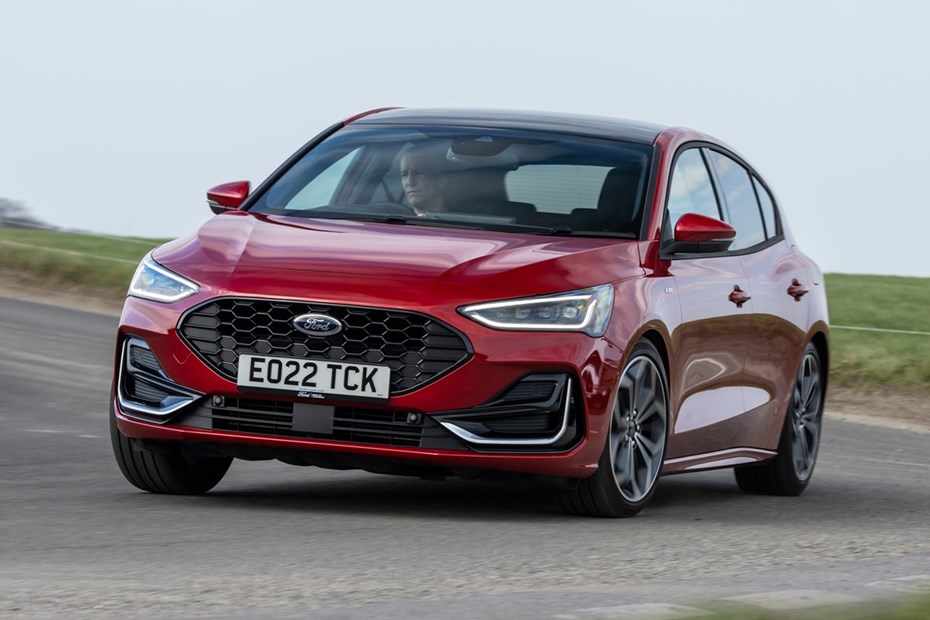
Ford Focus ST-Line X long term test
Update 1: Introduction
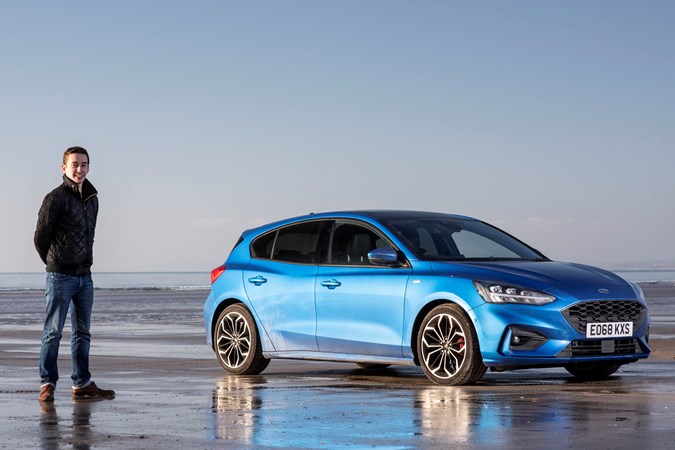
Introducing the fourth-generation Ford Focus hatchback. A favourite of the British car-buying public and a 2019 Parkers Awards winner, this Desert Island Blue ST-Line X Focus – in 120hp 1.5 TDCi spec – is in my care for the next few months, during which I plan to subject it to the finest that my 200-mile daily commute has to offer. What a lucky car.
And what a lucky ‘owner’. I’ve always fancied a Focus since I saw the first-generation RS model operating as pace car at the Goodwood Festival of Speed, it’s bold, sporty styling and genuine attainability making it seem far more attractive than the assembled supercars. Granted, this isn’t an RS model, but it does look the part nonetheless, oddly coming across far better in person than it does in any photo.
So without further or do, here’s all you need to know about our new addition.
Ford Focus: equipment and price
Coming in high-spec ST-Line X trim, there’s plenty of standard kit aboard the good ship Focus, including:
- Heated front seats
- 6-way power adjustable driver’s seat
- Ford Sync3 infotainment system with sat-nav, Apple CarPlay and Android Auto
- 4.2-inch TFT digital dashboard display
- Cruise control
- Selectable drive modes
- Dual-zone climate control
- Enough bodykit to make the car look almost identical to the upcoming ST
- Ford Focus interior
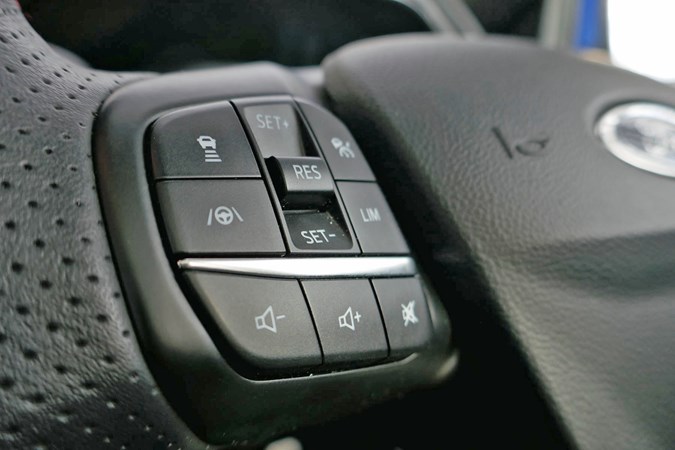
A tidy selection of kit, and one that brings the standard on the road price to £26,410. Throw in a few options however – like Ford’s press office has kindly done – and the total price increases to a rather un-Focus like £31,450 (a £5,040 premium). Additional gadgetry includes:
- Desert Island Blue paintjob (looks superb)
- Heads-up display
- Heated steering wheel (would have chipped in my own money for this)
- Driver Assistance Pack & Convenience Pack (more on what these do in a later update)
- B&O Play 10-speaker sound system with 675-watt amplifier and Digital Sound Processor (should drown out my shrill singing voice)
Needless to say, there’s plenty of talking points in the above kit list – all to be addressed as I spend more time with the Focus over the next few months. Remember to check back on this page next week as I deliver my first impressions of the car, and promptly discover it’s already been damaged in one of the worst possible places…
Mileage: 4036
Fuel economy: 64.2mpg (claimed)
Update 2: Performance and handling
Under the bonnet my of new steed is a 1.5-litre four-cylinder EcoBlue diesel, packing 120hp and 300Nm of torque. This translates into a 0-62mph time of 10.2 seconds, a top speed of 120mph, claimed average fuel economy of 64.2mpg and a CO2 output of 116g/km. The gearbox, meanwhile, is an eight-speed automatic with manual override via paddles on the steering wheel.
So, essentially, we’ve got a small (one of the smallest on sale), frugal diesel engine with moderate CO2 returns and average performance. In reality, it’s a competent, agreeable engine, yet I can’t help but feel I’d enjoy the car far more if it was upgraded to the 150hp 2.0-litre diesel. It would be unfair to say the 120hp version is slow, but it’s certainly not fast and I’ve been left wanting a few times for that extra bit of performance. It’s always very loud when cold, too, although this isn’t a massive issue.
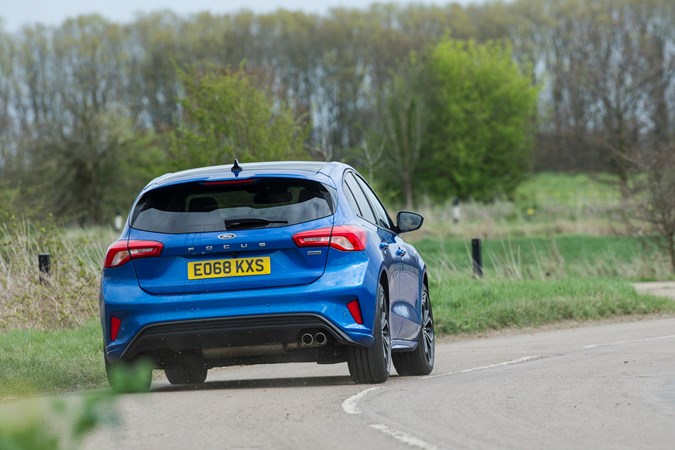
The gearbox, meanwhile, does a decent job of shuffling between the eight forward speeds, but it’s not as polished or crisp as a DSG Volkswagen Group unit. Down changes can often feel clunky, plus the override paddles behind the steering wheel fail to elicit a particularly snappy response from the actual gearbox.
Sweet-handling Focus is back
A quick history lesson. The original Ford Focus made an instant impact thanks partly to its fabulous handling and this was duly carried through into the second-generation car. The Mk3, version, however, was somewhat blunter to drive and allowed rivals such as the Volkswagen Golf, Vauxhall Astra and Mazda 3 to catch up.
Happily, though, it seems that Ford has made a return to form with this latest Focus. Early opportunities to throw it around a little have shown it to possess a poised, well-balanced chassis with tremendous grip from the front wheels. The weighting of the steering can feel a little odd at times, and I’m not sold on the feel of the brakes, but these issues aside the fourth-generation Focus handles superbly.
Mileage: 4393
Fuel economy: 34.3mpg
Update 3: Having a cracking time
Disaster. ‘My’ Ford Focus has taken damage in the most fragile of places. I’m not quite sure how it happened – the Clancy Docwra lorry that flicked stones up at the car is a prime suspect – but the end result is a small crack right in the corner of the windscreen.
Fearing the worst (can you even repair a heated windscreen?) I ring Ford and break the bad news. My fears over the possibility of a repair are – thankfully – unfounded. After examining the photos – Ford suggests that I go down to my local Halfords and get one of the on-site technicians to fill imperfection with that magic gooey stuff that – at the very least – reduces the chance of a humungous crack forming across the windscreen.

Once at Halford’s Uxbridge branch, the queue is short and my wounded Focus is seen immediately, the windscreen repairer looking excited as he recognises the shape of the fourth-generation Ford Focus. ‘I’ve got a Mk3 RS myself. Love it, but it’s a bit thirsty so I’m thinking of getting one of these’.
Our jovial chat is sadly ended, however, when he sees the location of the crack. Since it’s so close to the edge of the screen, the repair can’t be done without risk of cracking the entire piece of glass. Not something I knew, and I’m not alone according to the repairer, with many customers booking their car in not realising that a quick fix to the outer edge of the screen isn’t possible.
Running the Focus as a long-termer, I’m fortunate enough not to have to fit the bill for a brand-new windscreen, yet there’s no doubt that the heated element adds a fair chunk extra to the total repair bill.
Mileage: 5155
Fuel economy: 38.9mpg
Update 4: Interior and equipment
There’s been a bit of a disagreement in the office. Some of my ‘expert’ colleagues have decided that the Focus’ interior isn’t as good as a number of key rivals and that I – by running one – have become somewhat biased in favour of the blue hatch. While the latter may be true (it happens to all of us), the former – in my opinion – is certainly not.
Granted, some of the material quality could be better, but the overall design and ease of use granted by the Focus is superb. The steering wheel for example, is a lesson in ergonomic bliss. Nicely trimmed in ST-Line X leather, the buttons are easy to find and pleasant to the touch making volume or cruise control adjustment a cinch. Meanwhile, the centre console balances functionality between touch screen and physical dials perfectly. No faffing about to find the climate control or heated seat buttons.
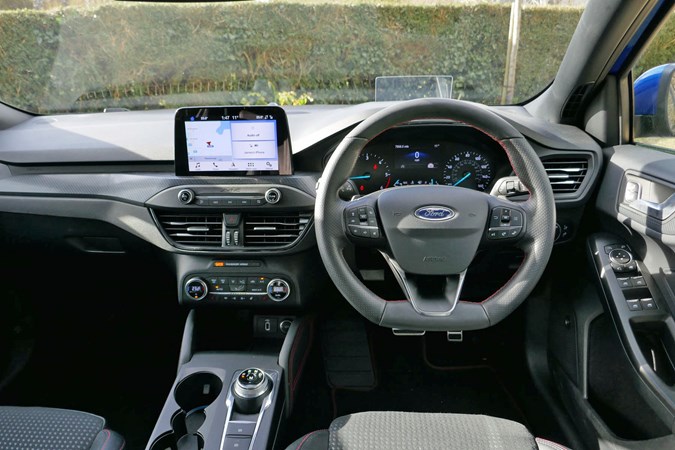
The equipment on offer is genuinely effective, too. The adaptive cruise control and lane guidance systems work better than on many cars costing three times as much, keeping the Focus at a constant distance from the vehicle in front and holding it deftly in lane. I’ve also taken much joy from the electric sunroof, standard-fit Apple CarPlay (the Ford sat-nav is good, but not as good as Waze) and sporty yet comfortable leather seats.
Not so good is the automatic parking function (which can be hit and miss, plus refuses to work when exiting a space) and the Bang & Olufsen stereo that, while powerful, keeps vibrating the driver’s side speaker. I suspect a full-bass thrash metal session from one of my unnamed colleagues (begins with Adam, ends with Binnie) could be responsible.
One other handy piece of kit that I feel is worth pointing out is the FordPass app and the additional functionality it gives.
Mileage, fuel and tyre pressures all accessible
Using the FordPass app (downloadable on the App Store and Google Play), I can see how much fuel is left in my car, how many miles it’s done, what the tyre pressures are and where it’s parked.
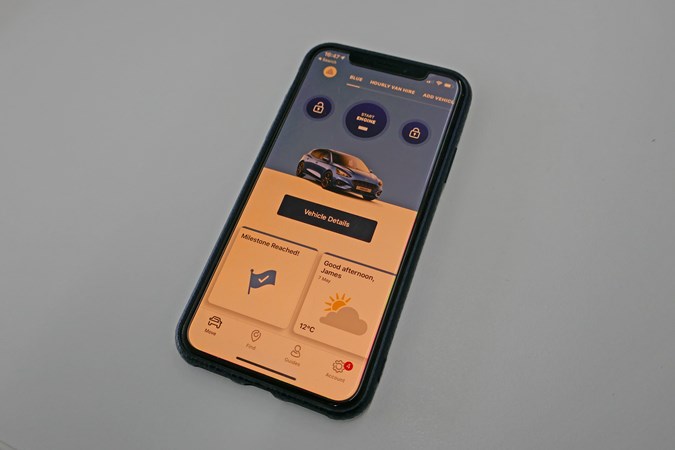
Such details may sound trivial, yet they’ve already come in useful. Forgetting how much fuel is left in your car is a common occurrence, while the ability to see where it’s parked helps keep an eye on errant airport valet parkers. I still haven’t had an explanation as to why my car needed to be parked outside Hounslow KFC at 2:30am last week…
Remote start and unlocking/locking
Perhaps the most impressive feature of the FordPass functionality, however, is the remote start and unlocking/locking. The former is only available on automatic versions (designed to ensure that car doesn’t jump forwards if left in gear) and allows you to launch the FordPass app, hit the start engine button and fire up your Focus from anywhere in the world. Clever.
Why would you want to do that?
For example, unless you’ve been living under a sun-proof rock, it’s been rather hot recently. And before that, as things go, it was jolly cold. Remote starting the Focus brings the car to a comfortable temperature, as well as defrosting the windscreen and cranking up the heated seats/steering wheel – if needs be. So no freezing cold morning starts, or climbing into a sweltering hot car after work. Joy.
I should make it clear at this point that remote starting the car does not simply allow you to walk up to it, get in and drive off. For starters, to access the car (even when it’s running) you need the key. Without this it remains locked just as if the engine were not running.
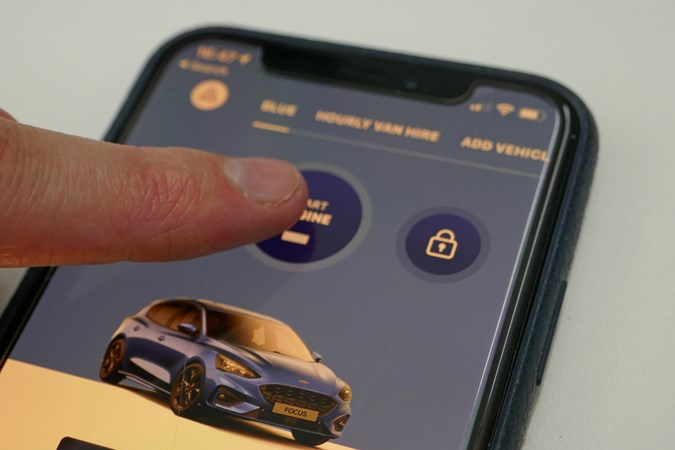
And once you do get in you still need to have the key on you and hit the on button if you want to move the vehicle, minimising the chance of the car getting stolen due to the remote start. Indeed, if the vehicle is left running too long without anyone getting in, it’ll automatically switch off again.
Mileage: 5809
Fuel economy: 41.5mpg
Update 5: Practicality/Comfort
As much as I like to pretend that it’s every bit the fire-breathing Focus RS hot hatch, my Desert Island Blue diesel Focus is, first and foremost, a family car. That means it needs to be practical, comfortable and easy to use above pretty much all else. Thankfully, the Focus largely excels in this department, but it’s worth digging a little deeper into its family bus credentials – especially if you’re interested in buying one.
Comfortable drive, but not without its compromises
I won’t pretend that the Focus is an effortlessly comfortable cruiser only a couple of steps down from a Rolls-Royce, because the truth is there are more relaxing hatchbacks on sale. Ride quality is perfectly acceptable, but be aware that the ST-Line (and ST-Line X)’s sporty suspension and larger 17/18-inch alloy wheels add an undesirable brittleness to the car’s bumpy road absorbing abilities. Also note that cars with the basic torsion beam rear suspension (those with less than 150hp) deliver a firmer ride and slightly inferior handling.
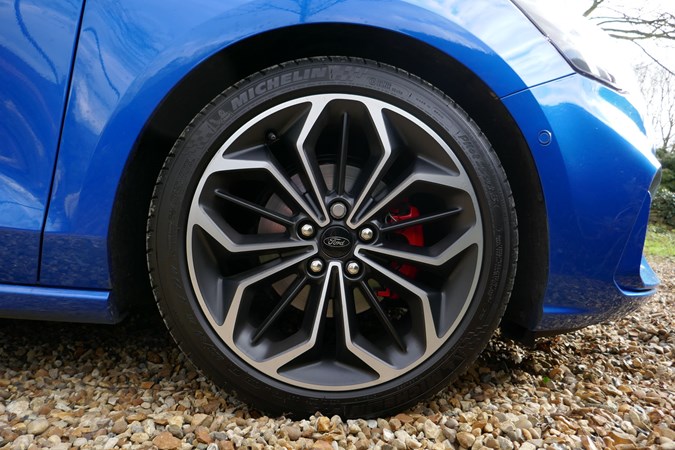
The 120hp 1.5-litre EcoBlue diesel engine is more than capable of pulling the Focus around – even when heavily laden with people and luggage – yet its refinement levels when cold are poor. Honestly, if you take a test drive and wonder why the engine is so noisy, give it 30 minutes (yes, 30 – it takes a while to properly warm up) and things become a lot more civilised. Wind and road noise levels are par for the course.
One thing that has made the Focus a lot easier (and more comfortable) to drive is the optional Driver Assistance Pack and the adaptive cruise control, Lane Centring Assist and Stop & Go functionality that’s included. With all the systems on it follows the car in front at a set speed while also taking care of the braking and steering (the driver still needs their hands on the wheel, however). As a way of making morning commute traffic jams that bit more bearable, it’s worth its weight in gold.
Spacious cabin and boot in the Focus
The Focus has one of the most spacious cabins among its immediate rivals, delivering copious amounts of passenger room front and rear. Of particular note is the generous rear leg room, even with the front seats set further back than average. I’ve ferried around a six-foot friend in the back of the car and they’ve fitted just fine, commenting that although some of the materials felt a little cheap there were no complaints for outright space. Meanwhile, the glovebox and space under the front armrest could be larger, however the door pockets are deceptively large.
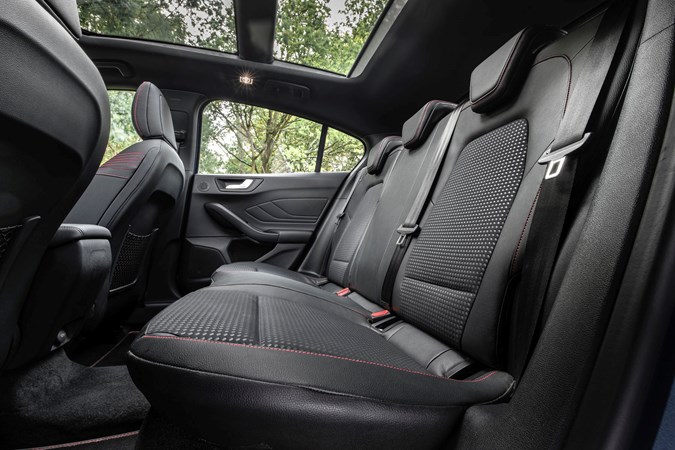
Boot space is reasonable, but can vary depending on whether you have the full-size spare wheel or B&O Play fitted. Opt for either and the space drops by around 20% – not ideal if you’re looking for maximum load-lugging capability. It’s still a good size, however, no matter which configuration you go for, and should be able to accommodate an average-size motoring journalist eating his fish and chips (see below). The lip up from the floor was the only uncomfortable part, however, and could well make it trickier to load or unload heavier items.
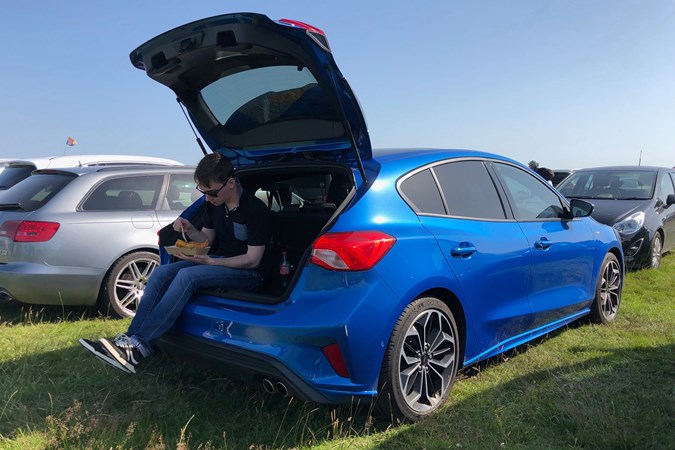
Mileage: 9521
Fuel economy: 43.4mpg
Update 6: Farewell and verdict
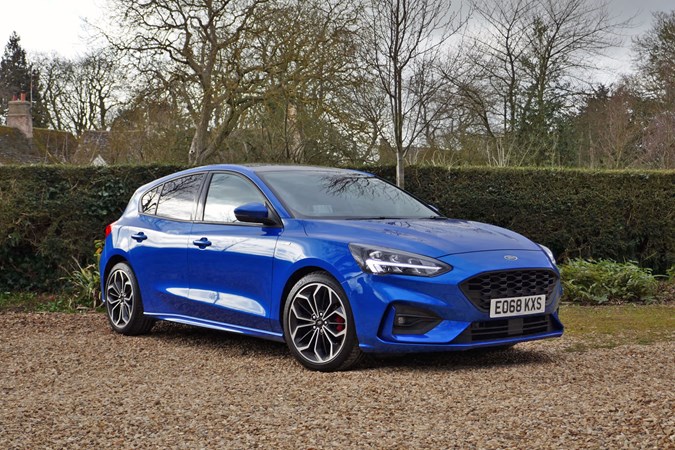
You always know whether you had a good long-term test car because once it’s gone back – like the Focus now has – you miss it. Not in the way you’d miss a partner, more so in the way you’d pine after a talented work colleague. Competent, reliable and a jolly nice person to boot. That’s what you want. And after six months with my Parkers long term Ford Focus, that’s where I find myself.
Read on for a summary of why I think ‘my’ now departed Desert Island Blue Ford Focus is going to leave a small – but well-formed – hole in my life.
First report was mostly positive
We know in advance what long-termers we’re getting from the manufacturers, so I had a pretty good idea of what the Focus would look and drive like. After all, I had done the international launch in Nice just a few months earlier and declared to my colleagues that the Focus was the best medium-sized sensible family hatchback that money could buy.
I was also taken in hook, line and sinker by the sporty exterior styling of my high-spec ST-Line X Focus – its sharp bodykit and vibrant paintjob reminding me of the Mk1 Focus RS I’d so lusted after as a kid. My first drive in the car proved my ‘best that money can buy’ declaration correct (in my head at least), the Focus easily swallowing my 200-mile round commute – even if it did appear to initially be using more fuel than expected.
On the sporty side of things, however, I was yet to be convinced. This was very much a personal preference as many buyers won’t care one iota for their family hatch feeling like a sportscar, but I was hoping for a little more zing from the 1.5-litre TDCI EcoBlue engine. No complaints about cornering ability, though, even if the multi-link rear axle versions of the Focus are definitely the ones to have.
I was also enjoying the sheer amount of kit on EO68 KXS. Heated front seats, heated steering wheel, sunroof, adaptive cruise control with Lane Centring Assist (that actually worked) and FordPass remote start were all included in the £31,450 price tag – as they should be for that kind of money!
Second update gave an in-depth look at performance and handling
Following neatly on from my initial reservations, the second update saw me take a closer look at how the Focus performed in a straight line and through the bends. I declared the engine to be fine for keeping up with traffic, but lacking in the sort of oomph you want for longer journeys or swift overtakes. The eight-speed automatic gearbox, too, was adept during relaxed driving, but suffered when you asked any more of it.
In all honesty, such complaints are partly down to my inner boy racer, always wanting a car to be that little bit quicker than it comes out of the box. However, I stand by the notion that the punchier 150hp 2.0-litre diesel is the one to get if you do many motorway miles or just have a need for speed. What’s more, the six-speed manual gearbox is one of the sweetest around in this type of car.
What you also get with the 150hp 2.0-litre diesel is the more advance multi-link rear suspension – something that makes the car both handle and ride better. However, even with the standard setup on my long-termer I had few complaints. It’s a blast through a series of tight bends (only let down by the lackadaisical nature of the gearbox) and grips the road was admirable conviction, seldom feeling out of its depth.
Meanwhile, the ride comfort (initially a concern with those 18-inch alloys and firmer ST-Line/ST-Line X suspension) soon became more than tolerable – especially at higher speeds. Granted, it could have been better, but the odd intrusion from potholes and bumps wasn’t enough to spoil the driving experience.
Cracked it on the third report
Not the Christmas present I (or Ford UK) was after. Shortly before Christmas I took the Focus to my local Halfords branch to see if they could fix a chip that had appeared in the otherwise unblemished windscreen.
My initial concern was over whether you could indeed fix a heated windscreen, yet the biggest problem turned out to be far simpler. Because the imperfection was so close to the edge of the screen, the man at Halfords told me that they couldn’t do anything without cracking the glass. So, no repair and a new screen needed. Bah humbug.
Focus’ interior causes an argument in fourth update
The Focus’s interior is one of the best out of all of its rivals. Some of my colleagues may disagree but I’m standing my ground on this one. Yes, a few of the materials could be a little more ‘premium’ and nicer to the touch, but for the most part it’s a lesson in excellent judgement and taste.
The sporty ST-Line steering wheel, the comfy sports seats, the easy-to-operate climate control dials and rotary volume controller, the clear but still visually attractive dashboard and the logical all-round layout – to name but a few highlights– are all major plus points on a day-to-day basis. In fact, the cabin has probably been one of my favourite parts about the Focus. If only the infotainment system software was a little quicker and more elegantly designed…
Doubling up as a fish and chip dining spot in report five
Despite the header, this update was about more than what the Focus was like as a fish and chip eating venue (incidentally, it was very good at this). No, here we looked at comfort and practicality. We’d already touched on ride quality and the excellent seats, this was more focused on examining the driver assistance tech and what it’s like when you’re carrying passengers (and their luggage).
One particular highlight was the optional Driver Assistance Pack, including adaptive cruise control, Lane Centring Assist and Stop & Go functionality. Said technology effectively allows the Focus to ‘drive itself’ in traffic jams (obviously, when I say drive itself, I mean that the car takes control of the steering, brakes and throttle, yet you still have to keep your hands on the wheel and pay attention). It works well and puts systems on some pricier cars to shame, reducing the tedium of long and all too frequent tailbacks.
As for outright passenger space, the Focus delivers in spades. Up front, there’s oodles of room, yet it’s in the back where things get really impressive. Headroom (even with the panoramic sunroof fitted), legroom and kneeroom is excellent and only falls short of the Skoda Octavia for sheer space. There’s even a reasonable amount of storage space out back – although a couple of USB charging points behind the front armrest wouldn’t go amiss…
Bootspace is similarly pleasing, although it’s worth noting that the optional B&O Play sound system (when fitted) reduces outright capacity.
The Final Verdict
I’ll spare you the dramatic build up. The Ford Focus is the best small family car currently on sale. End of.
It’s comfortable, handles well, comes with a broad range of engines and trim levels, is packed with tech and should be available with endless tempting discounts. Concerns over the sometimes-sluggish automatic gearbox and pointless (optional) adaptive dampers are valid, plus we really could do with an electric or plug-in hybrid version. Otherwise, it’s not hard to see why the Focus is and continues to be one of Britain’s best-selling cars. Farewell EO68 KXS.
Final mileage: 11,114
Fuel economy: 44.2mpg




